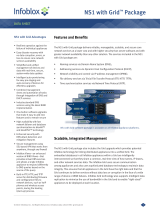
Dell Networking W-Series
Instant Access Point
Quick Start Guide
This Quick Start Guide assists you to connect and configure Dell Networking W-
Series Instant Access Point (W-IAP). To learn more about W-IAP and for detailed
configuration information, see Dell Networking W-Series Instant Access Point User
Guide.
Getting Started
Unpack and Power on W-IAP
After unpacking the W-IAP, check the power requirements and connect the
W-IAP.
Connect
To connect the W-IAP to your network, plug in a LAN cable to Ethernet port (on
the back side of the device). The Ethernet port LED turns green.
Provision
W-IAPs can be provisioned automatically, through Dell W-AirWave or by
manually connecting to a provisioning network. Use the following methods based
on your W-IAP provisioning requirements.
Functional W-IAP in the Network
If a W-IAP is already configured and is in operational state, connect the W-IAP
into the same VLAN or subnet, to automatically configure the new W-IAP.
Note: Based on the W-IAP model, you can power on the W-IAP by using an AC
adapter or Power over Ethernet (PoE). Use the option that suits your W-IAP
deployment environment.
Dell W-Instant UI
Dell W-Instant user interface (UI) is a standard web-based interface that allows
you to configure and monitor a W-IAP network.
To start using the Dell W-Instant UI, perform the following steps:
1. Using a wireless client, scan the wireless networks and connect to the instant
SSID.
2. Using a web browser, go to instant.dell-pcw.com.
3. Log in to the Dell W-Instant UI with admin and admin as username and
password respectively.
4. If the Country Code window is displayed after a successful login, select a
country from the list.
5. If the Dell W-Instant UI is used for managing W-IAPs, proceed to Creating a
Wireless Network. If W-AirWave is deployed for managing the network,
perform the following steps.
a. Navigate to System>Admin in the Dell W-Instant UI to configure W-
AirWave. The window with W-AirWave configuration options is displayed.
b. In the AirWave section, enter the Shared Key and AirWave IP details.
Contact your local network administrator to obtain these details.
Creating a Wireless Network
To create a wireless network using the Dell W-Instant UI, perform the following
steps:
1. From the Dell W-Instant UI main window, click New under the Networks
section. The New WLAN window is displayed.
2. In the WLAN Settings tab, enter a name (SSID) for the network. This name is
used for identifying the Network.
3. Click Next. The VLAN tab details are displayed.
4. In the VLAN tab, select the required Client IP assignment and Client VLAN
assignment options.
5. Click Next. The Security tab details are displayed.
6. In the Security tab, enter a unique passphrase and retype it to confirm. You can
use the default values or customize the security settings.
7. Click Next. The Access tab details are displayed.
8. In the Access tab, ensure that the Unrestricted access control is specified.
9. Click
Finish. The new network is added and displayed in the Networks
window.
For more information on configuring different types of wireless network such as
Employee, Guest, or Voice, see Dell Networking W-Series Instant Access Point User
Guide.
Verifying the Operating Status
After setting up a W-IAP and creating a wireless network, use the Dell W-Instant
UI or the LEDs to verify the operating status.
Verifying Status Using LEDs
You can use the LEDs to verify that both radios are active after the AP
initialization and configuration.
The following table lists the Ethernet ports available on a W-IAP and the
corresponding status indication:
For information on the LED status indicators, see the Installation Guide provided
with the W-IAP package.
Verifying Status Using Dell W-Instant UI
To verify that the wireless network is available and the SSID is broadcasted,
perform the following steps:
1. Verify that the newly created network is displayed in the Networks window:
for example, employee_network as shown in Figure 1.
Figure 1 Network Window
Note: It is recommended that you change the administrator credentials after the
initial configuration. For more information, see the Management Authentication
Settings section in Dell Networking W-Series Instant Access Point User Guide.
Note: The Country Code window is displayed only when the W-IAP-ROW (Rest of
World) variants are installed. The country code setting is not applicable to the
W-IAPs designed for US and Japan.
W-IAP Model Ethernet Ports
W-IAP134/135 ENET0: Indicates uplink connection.
ENET1: Indicates wired downlink connection.
W-IAP3WN/3WNP E0: Indicates uplink connection.
E1 and E2: Indicate wired downlink connection.
NOTE: The E2 port on W-IAP3WNP supports Power Sourcing
Equipment (PSE) to supply power to any compliant 802.3af powered
(class 0-4) device.
W-IAP108/109 ENET0: Indicates uplink connection.
ENET1: Indicates wired downlink connection.
W-IAP155/155P E0: Indicates uplink connection.
E1, E2, E3, and E4: Indicate wired downlink connection.
NOTE: The W-IAP155P supports PSE for 802.3at powered device
(class 0-4) on one port (E1 or E2), or 802.3af powered DC IN (Power
Socket) on two ports (E1 and E2).
W-IAP224/225 ENET0: Indicates uplink connection.
ENET1: Indicates wired downlink connection.
NOTE: When operating on 802.3af, only the port connected to power
is usable. For example, if the source of power is connected to ENET
0, then ENET 1 will not work.
W-IAP114/115 ENET: Indicates uplink connection.
W-IAP Model Ethernet Ports



